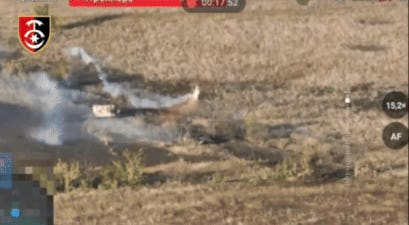In early September, Ukrainian forces began deploying hovering drones equipped with tanks full of thermite, a metal incendiary that sprays like a liquid and burns as hot as 5,000 degrees Fahrenheit. Russian forces cobbled together their own versions of the Ukrainian “dragon drone” a few weeks later.
The dragon drones have mostly attacked bunkers, trenches and their occupants—the operators apparently calculating that structures and troops are most vulnerable to sticky incendiaries that can kill a human being in seconds.
But incendiaries work against armored vehicles, too, as one Ukrainian brigade apparently discovered—more accurately, rediscovered—in eastern Ukraine this week.
On or before Thursday, the Ukrainian army’s 30th Mechanized Brigade, holding the line around Minkivka, 40 miles north of the Ukrainian fortress town of Pokrovsk, spotted a solitary Russian tank—perhaps from the nearby Russian North-V Volunteer Brigade—rolling along a treeline road in broad daylight.
As a Ukrainian drone observed from a distance, Ukrainian troops struck the tank—possibly with an anti-tank missile. The initial hit immobilized the up-armored “turtle tank,” making it an easy target for a follow-on attack.
It seems one of the 30th Mechanized Brigade’s dragon drones was in the best position to finish off the tank. It hovered overhead, spraying the lava-like thermite all over the tank. Soon, the tank was a pyre. “Probably the first documented case of a dragon drone striking Russian armored vehicles,” commented WarTranslated, an Estonian analyst.
That incendiaries are effective anti-tank weapons should come as no surprise, even if it took a few weeks for Russian and Ukrainian drone operators to appreciate it.
“When napalm is splashed onto a tank, the combustible material on the surface of the tank may catch fire, rubber on the tracks and road wheels may ignite, exposed hydraulic hoses may rupture and engine compartments may be damaged,” the U.S. Army noted in a 2000 study.
The damage would be worse in cases where infantry are riding on top of the tank—a common tactic in Russia’s 31-month wider war on Ukraine. “Napalm also can ignite exterior-mounted ammunition, which may then cause secondary blast or fragmentation damage when it cooks off,” the U.S. Army observed. “This secondary blast or fire can be a serious threat to mounted soldiers.”
Don’t expect a sudden surge in dragon drone attacks on tanks. The drones’ incendiary spray is fairly inaccurate, which is why the 30th Mechanized Brigade had to immobilize that Russian tank before the brigade’s dragon drone could swoop in.
But drone operators in the Russia-Ukraine war learn fast. Some Ukrainian operators of nimble first-person-view drones are so skilled that they can strike Russian drones in mid-air—or maneuver their explosive FPVs underneath the lips of the add-on armored shells on Russian turtle tanks.
With time, the dragon drone operators will become more skilled, too. It might not be long before they can burn down enemy tanks while the tanks are still on the move.
MORE FROM FORBES
Read the full article here





